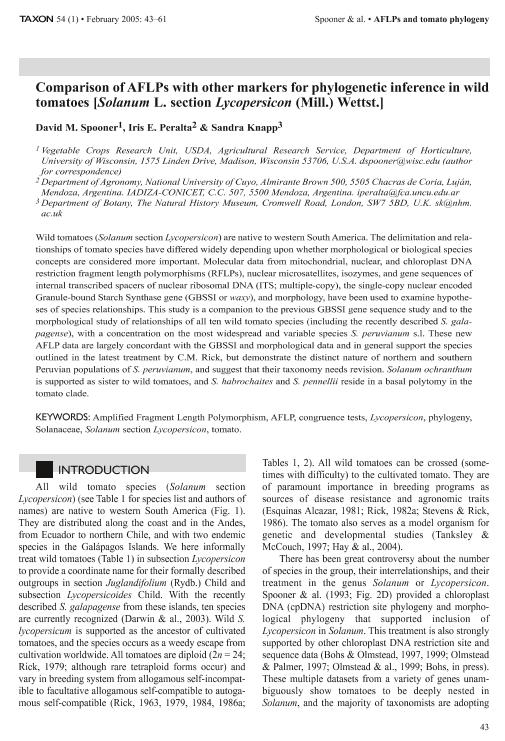Mostrar el registro sencillo del ítem
dc.contributor.author
Spooner, David M.
dc.contributor.author
Peralta, Iris Edith

dc.contributor.author
Knapp, Sandra
dc.date.available
2020-06-18T17:51:15Z
dc.date.issued
2005-02
dc.identifier.citation
Spooner, David M.; Peralta, Iris Edith; Knapp, Sandra; Comparison of AFLPs with other markers for phylogenetic inference in wild tomatoes [ Solanum L. section Lycopersicon (Mill.) Wettst.]; International Association for Plant Taxonomy; Taxon; 54; 1; 2-2005; 43-61
dc.identifier.issn
0040-0262
dc.identifier.uri
http://hdl.handle.net/11336/107625
dc.description.abstract
Wild tomatoes (Solanum section Lycopersicon) are native to western South America. The delimitation and relationships of tomato species have differed widely depending upon whether morphological or biological species concepts are considered more important. Molecular data from mitochondrial, nuclear, and chloroplast DNA restriction fragment length polymorphisms (RFLPs), nuclear microsatellites, isozymes, and gene sequences of internal transcribed spacers of nuclear ribosomal DNA (ITS; multiple-copy), the single-copy nuclear encoded Granule-bound Starch Synthase gene (GBSSI or waxy), and morphology, have been used to examine hypotheses of species relationships. This study is a companion to the previous GBSSI gene sequence study and to the morphological study of relationships of all ten wild tomato species (including the recently described S. galapagense), with a concentration on the most widespread and variable species S. peruvianum s.l. These new AFLP data are largely concordant with the GBSSI and morphological data and in general support the species outlined in the latest treatment by C.M. Rick, but demonstrate the distinct nature of northern and southern Peruvian populations of S. peruvianum, and suggest that their taxonomy needs revision. Solanum ochranthum is supported as sister to wild tomatoes, and S. habrochaites and S. pennellii reside in a basal polytomy in the tomato clade.
dc.format
application/pdf
dc.language.iso
eng
dc.publisher
International Association for Plant Taxonomy

dc.rights
info:eu-repo/semantics/openAccess
dc.rights.uri
https://creativecommons.org/licenses/by-nc-sa/2.5/ar/
dc.subject
AMPLIFIED FRAGMENT LENGTH POLYMORPHISM
dc.subject
AFLP
dc.subject
CONGRUENCE TEST
dc.subject
LYCOPERSICON
dc.subject
PHYLOGENY
dc.subject
SOLANACEAE
dc.subject
SOLANUM SECT. LYCOPERSICON
dc.subject
TOMATO
dc.subject.classification
Ciencias de las Plantas, Botánica

dc.subject.classification
Ciencias Biológicas

dc.subject.classification
CIENCIAS NATURALES Y EXACTAS

dc.title
Comparison of AFLPs with other markers for phylogenetic inference in wild tomatoes [ Solanum L. section Lycopersicon (Mill.) Wettst.]
dc.type
info:eu-repo/semantics/article
dc.type
info:ar-repo/semantics/artículo
dc.type
info:eu-repo/semantics/publishedVersion
dc.date.updated
2020-03-19T14:37:50Z
dc.journal.volume
54
dc.journal.number
1
dc.journal.pagination
43-61
dc.journal.pais
Estados Unidos

dc.journal.ciudad
Washington
dc.description.fil
Fil: Spooner, David M.. University of Wisconsin; Estados Unidos
dc.description.fil
Fil: Peralta, Iris Edith. Consejo Nacional de Investigaciones Científicas y Técnicas. Centro Científico Tecnológico Conicet - Mendoza. Instituto Argentino de Investigaciones de las Zonas Áridas. Provincia de Mendoza. Instituto Argentino de Investigaciones de las Zonas Áridas. Universidad Nacional de Cuyo. Instituto Argentino de Investigaciones de las Zonas Áridas; Argentina
dc.description.fil
Fil: Knapp, Sandra. The Natural History Museum; Reino Unido
dc.journal.title
Taxon

dc.relation.alternativeid
info:eu-repo/semantics/altIdentifier/url/https://onlinelibrary.wiley.com/doi/10.2307/25065301
dc.relation.alternativeid
info:eu-repo/semantics/altIdentifier/doi/https://doi.org/10.2307/25065301
Archivos asociados
